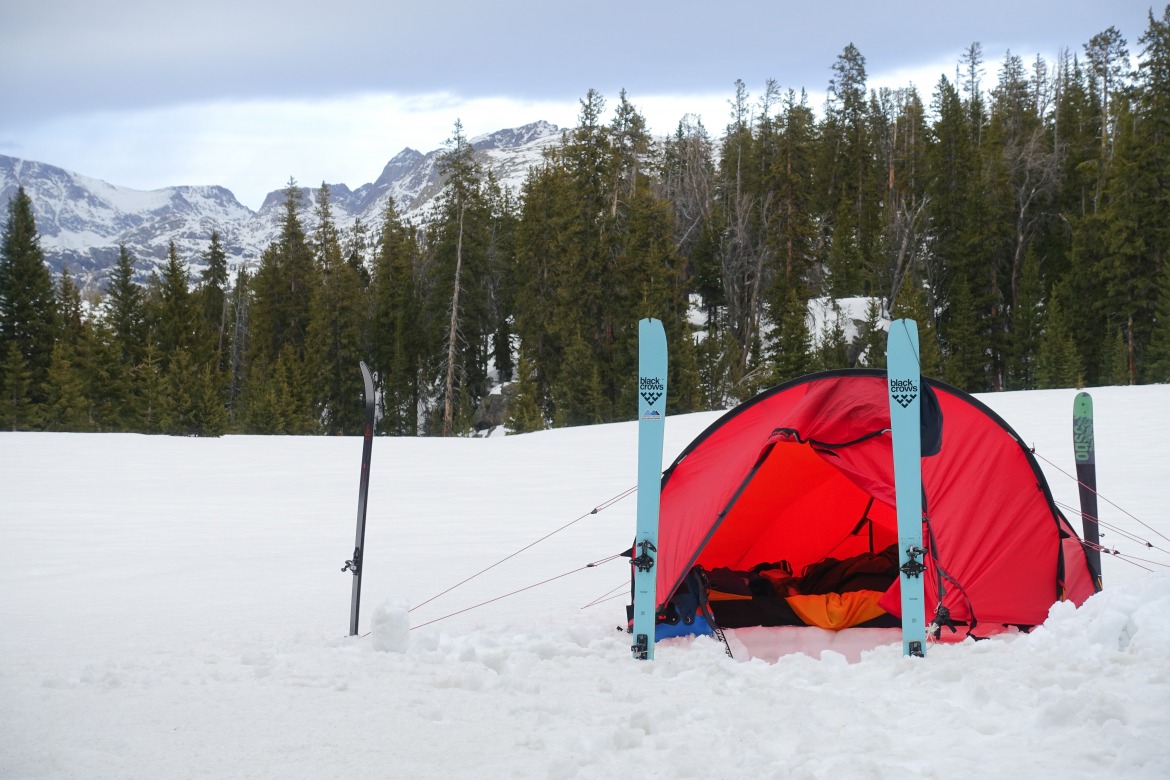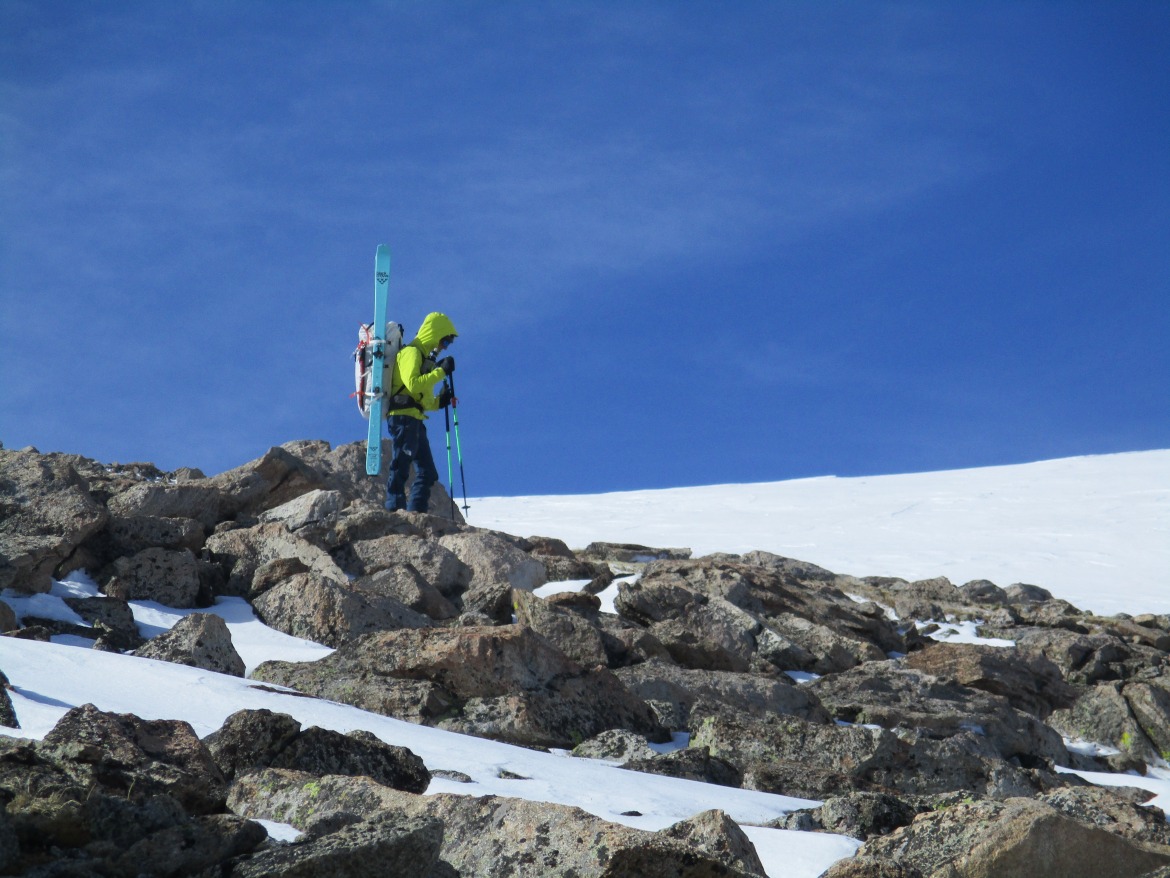
Either under your boots or on your pack, the Mentis Freebird is solid choice for traverse style skiing. Photo: Brian Parker.
The Black Crows Mentis Freebird in its 80mm underfoot glory skis like a champ and is easy on the ups. Here’s a review of the Mentis Freebird after a season of use.
Weight: approximately 1060g (178cm) verified.
Lengths: 157, 164, 171, 178 cm.
Dimensions: 111mm, 80mm, 101mm (178cm)
Turn radius: 19m.
Profile: Slight Rocker Tip / traditional camber.
Construction: Semi Cap, near full ABS sidewall.
Core: Paulownia, minimal carbon, and fiberglass.
Bindings: BD Helio 200LT
Boots: Fischer Travers Carbon, Salomon S/LAB MTN Summit, Dynafit TLT X.
Price: $949.95
There you have the stats upfront. The numbers, the Chamonix water, the Black Crows marketing magic, whatever has aligned here in the Mentis Freebird; it works.
Read the Mentis Freebird first look (extended version).
Not all winters are the magic of deep powder, fist bumps before dropping in after the ridge top heli-drop off (watch most ski-movie trailers now…), or high flying hucks and spins with a commissioned photographer to capture the moment. No. Sometimes the magic comes in the form of mid-winter high pressure, icy and chattery slopes, thin creamy veneers of snow, and lots of uphilling. That’s also a form of magic we can fist bump to at WildSnow, and it’s the kind of magic the Mentis Freebird masters.
As noted for anyone out West last season, prime powder skiing arrived in spring. For much of it, the ski season was a season for skinnier skis, in the 90mm and down range.
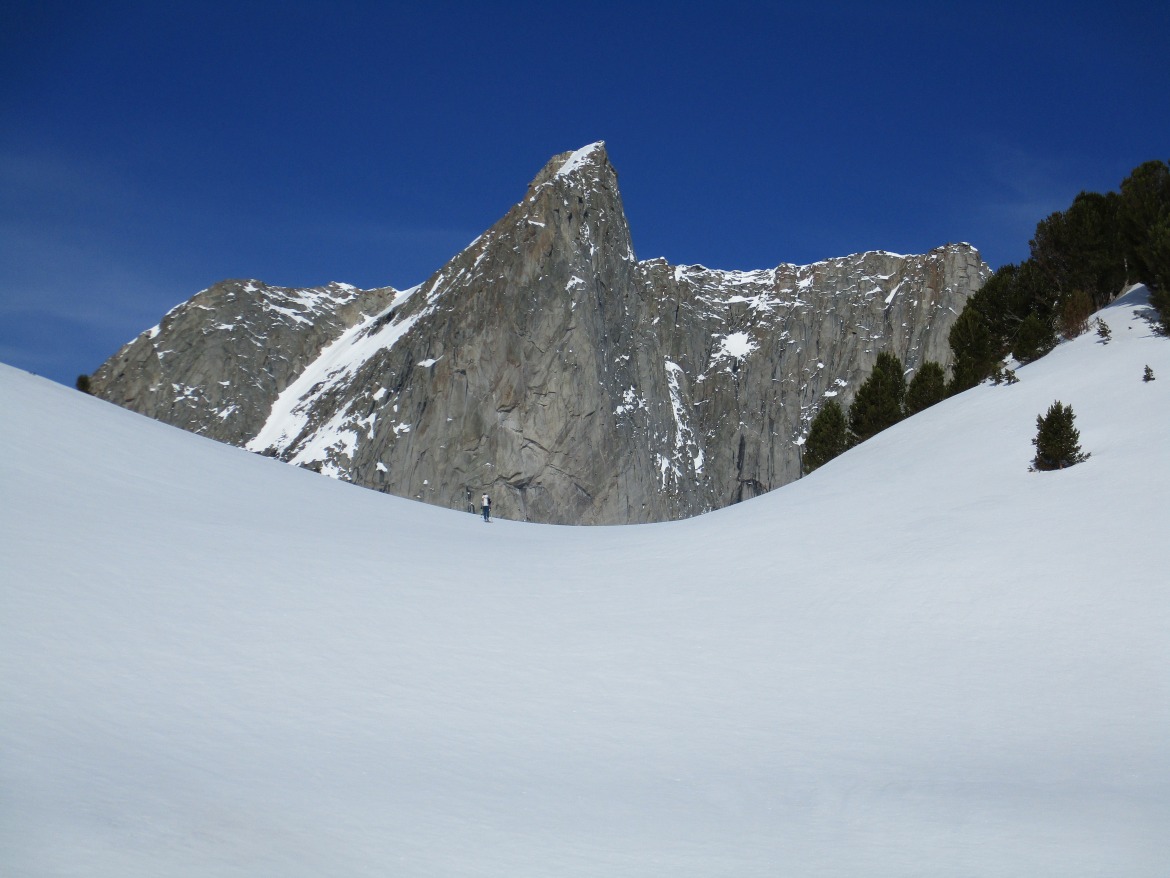
For springtime adventures, the ~1000kg Mentis Freebird arrives light yet with a traditional shape for stability in steep and firm terrain. The Mentis, on this trip to the Winds, was a wise ski choice. Photo: Brian Parker.
Why I chose the Mentis Freebird
Simple to answer: I wanted a skinnier ski offering an un-noodly experience, in an ~1000g weight, and a turn radius of at least 18m. The 178cm Mentis Freebird clears those metric hurdles. I also wanted to try a slightly longer ski on traverses than I am accustomed to. Over the years, I’ve vacillated between a 165cm Dynafit PDG, 170cm Hagan Ultra 82, and 170cm Salomon X-Alps when choosing a strict uphilling and traverse-oriented ski. The PDG is/was light, but maybe too light for awful conditions, which 100% will be encountered on a large traverse. The other two skis are solid and praiseworthy, beyond me wanting a full-value light ski more stable in the GS turn department.
Mentis Freebird Limitations
The limitations of the Mentis Freebird are obvious; this is not the ski of choice for deep, soft snow. There’s a deficient surface area for great float and insufficient tip rocker. Again, you likely know this. For pure skimo folks out there, even the lighter 170cm Mentis Freebird might be too hefty for those looking for the podium or a PR edge. Roughly 1000g for 170cm of Mentis Freebird is asking perhaps too much from those replicating a World Cup setup. And lastly, in truly variable conditions, like god-awful six inches of breakable crust, the Mentis Freebird will get you down, but it’ll be a rough and slow ride.
And trail breaking in deep fresh snow with the Mentis Freebird will be more work than using a plank with a soft, rockered, and broad tip.
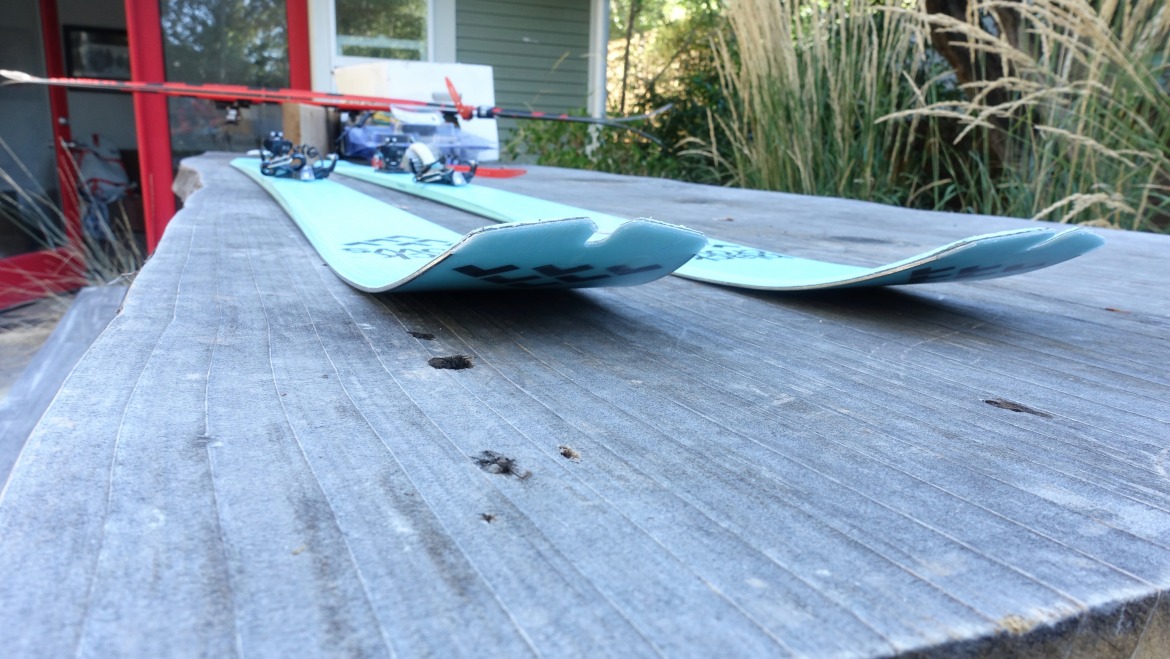
The Mentis Freebird is a traditionally shaped ski, with little tip rocker. This design offers excellent edge hold on firm snow.
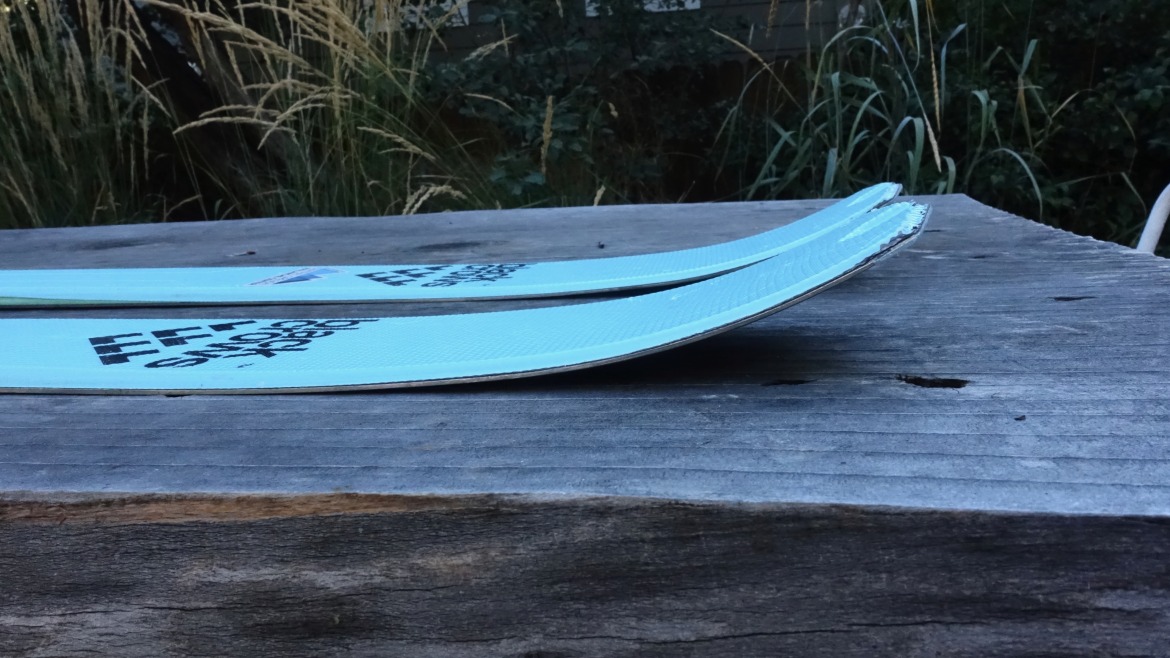
A side view of the Mentis Freebird’s tips: note the lack of rocker. Although not powder boards, these 80mm wide skis are excellent firm snow skis.
Where the Mentis Freebird Thrives
The Mentis Freebird offers all the good blessings of lightness while serving a tasty treat on the descents for the on-piste uphiller and fitness skier. Pair the Mentis Freebird with a light ~200g binding, slap on a pink race skin with a race-style tip attachment, and be ready to fly. The Mentis Freebird was my ski of choice for area uphilling due to the above attributes (see why I chose the Mentis Freebird). But on the descents, when at an area, I seek neither bumps nor anything rough and tumble, which the Mentis Freebird can tolerate to some degree; I’m seeking firm, smooth snow if not early-bird corduroy. I love how this light plank holds an edge and wants to arc a turn seemingly longer than its prescribed 19m turn radius. The tip and tails are stiff; they hold and then release smoothly throughout a turn, yet are damp enough to eliminate most chatter. The ski’s midsection holds strong and torsionally rigid as well.
If you seek a steep skiing machine for spring in the 80mm underfoot genre, the Mentis Freebird thrives here too. Again, its somewhat traditional build, rocker-camber-rocker (and little rocker at that), offers an ample effective edge for jump turning and navigating puckery terrain. Just know it is skinny, and the tip shovel tapers to thin to keep the tip’s mass down. You’ll be reminded of this construction when head-down charging ahead through an apron rife with debris.
For many readers, covering an immense amount of terrain is tantamount. From big single-day efforts to multi-day traverses, while wearing a 40-pound pack, the Mentis Freebird should have you covered. (That said, if it’s mid-winter and the storm cycle is in dump mode, pick a wider ski.) If the word “traverse” crossed my lips when describing a day’s outing, I grabbed the Mentis Freebirds. So yes, when I packed for a Winds traverse in May, the Mentis Freebird came along. The skis’ traditional straight tail slots into firm snow easily to use as a shelter anchor. It’s also a light ski. And it shines in firm conditions, which is what we mostly found.
I can recall a single moment on that traverse when I pushed the ski past its limits.
Due to an incoming storm and a cornice blocking our desired path, we decided to punch over the divide high above Island Lake. The skiing, while technical up high, became open-it-up amazing lower down. On this still-in-shadow west face, the snow surface was firm. While descending, I got ahead of myself and began playing with how much the TLT X boots I wore could make this ski bite into a big and fast turn. I’m guessing I still shouldered a 30-pound pack — I’d consumed 4.5 days of food up to that point.
My outside ski must have awoken the mountain gods on the wrong side of the bed. The tip began to vibrate on one high speed turn, and only on this turn. But it was enough to scare the crap out of me; thinking of yarding headfirst into a rock or pile driving a shoulder into the snow, instantly made me snap into conservative skiing norms.
Besides that two-second ski oscillation, the Mentis Freebird is a skinnier ski to behold.
While the ski, with its modernist tip design and glacial lake color, speaks to high-design sensibilities, the Mentis Freebird is genuinely a mountaineer’s ski as well. If you want to go longer and further and still use a ski suitable for most spring conditions, it’s OK to be tempted by the Mentis Freebird.
The Mentis Freebird can also be a great tool for a ski-alpinists ascending technical ground but desiring a stable and somewhat larger ski on the descent; it’s light enough and minimalist enough to supplant a race ski. In other words, the ski is light enough to toss on your pack, ascend more technical terrain, and feel confident the Mentis Freebirds are under your feet while descending. And yes, I’ve made the distinction between mountaineering and alpinism, as that distinction has also entered the lexicon of the backcountry realm.
This brings me to think about durability — the Mentis Freebird will be more durable than a race ski. I’ve not coddled these skis. And after a season of heavy use, the bases look great and the topsheet shows minimal wear near the tips. (The tails are reinforced and show no evident wear.)
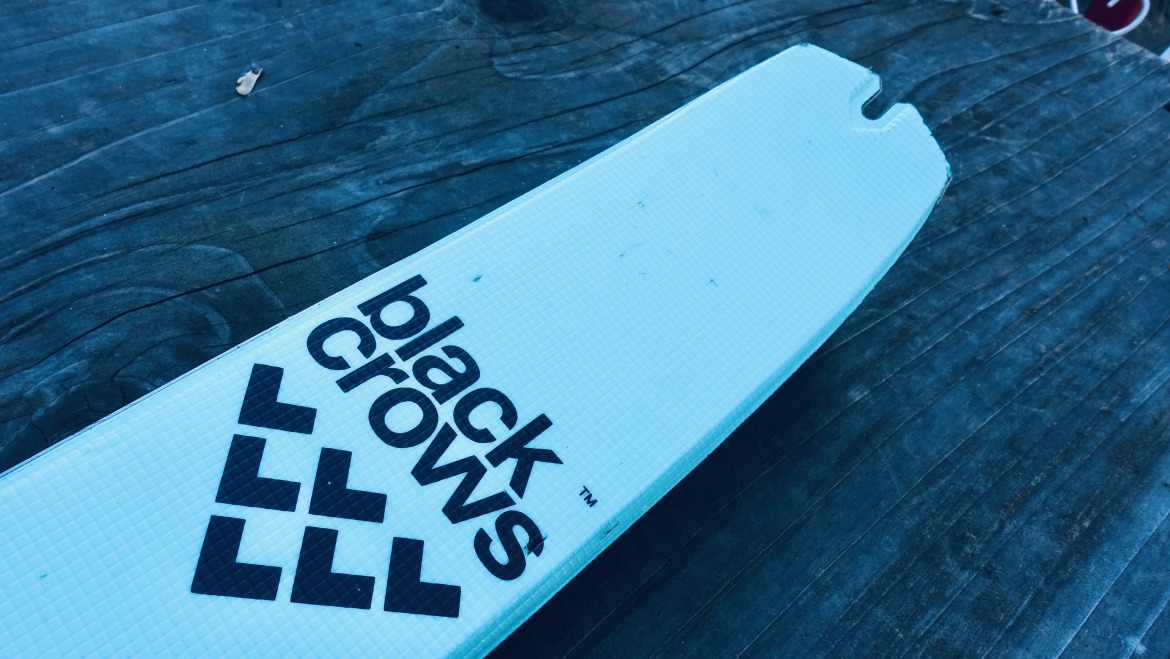
Near the tip edge, the top sheet of the Mentis Freebird chipped sightly over the course of a season.
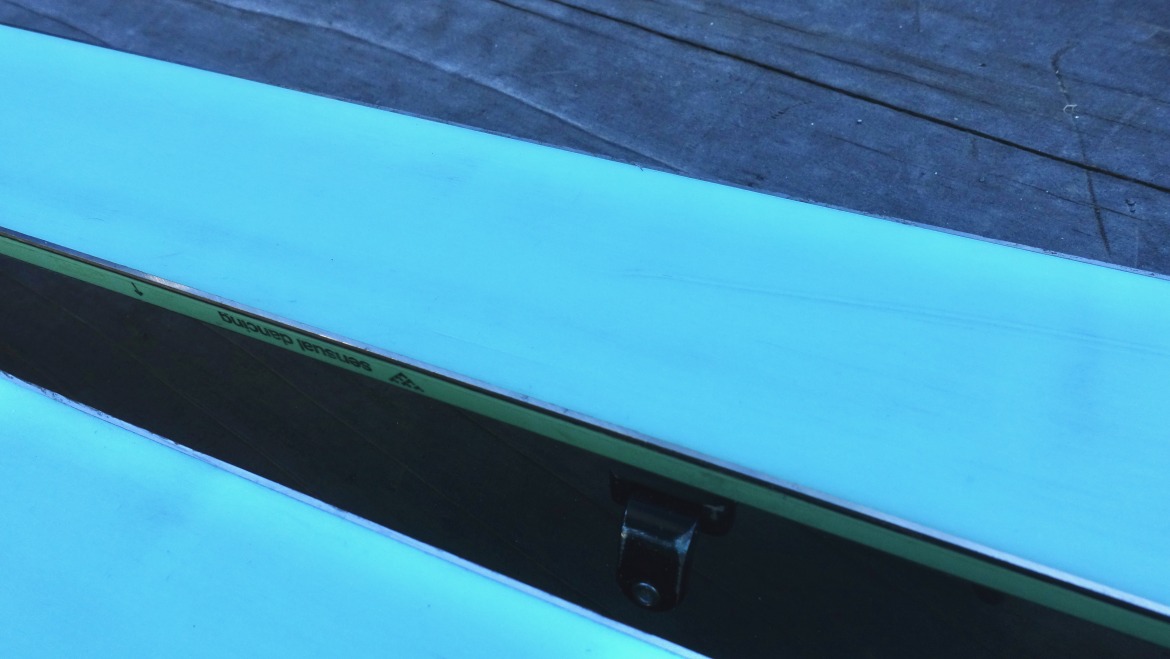
With normal wear and tear on the ski’s bases, and some heavy rock hits, the Mentis’ bases have held up nicely.
Options
It’s worth it here to think about ski options and preferences. The two skis I used last season that overlap somewhat are the Mentis Freebird and the 22/23 Blizzard Zero G 95. I love both skis. And I am trying to get ahead of a comment asking which ski I prefer. It’s hard for me to come down either way. But here is my logic if throwing down the cash for one ski. I’d ask myself this: do I plan primarily to uphill and traverse? Or do I want to add in some single-day steep and spicy objectives for good measure?
The Mentis Freebird handled 40-degree dirty ice with a heavy pack on the traverse. But, now I was skiing conservatively with methodical jump turns and, yes, the occasional side slip. Still, if I’m thinking of a one-day out-and-back steep line objective, I do like the sensation of the Zero G 95’s slightly wider platform for higher consequence skiing, although I skied that in 171cm. If you are someone who loves the 80mm sensation on the springtime steeps, you cannot lose on the Mentis Freebird. To some, this is apples to apples, others apples to oranges— apologies.
Other skis in the Mentis Freebird class recently reviewed by WildSnow include:
- Dynafit Blacklight Pro — (read our full review)
- Black Diamond Cirque 78 — (read our full review)
- Atomic Backland 85 — (read our full review)
- Ski Trab Magico.2 — (read our our full review)
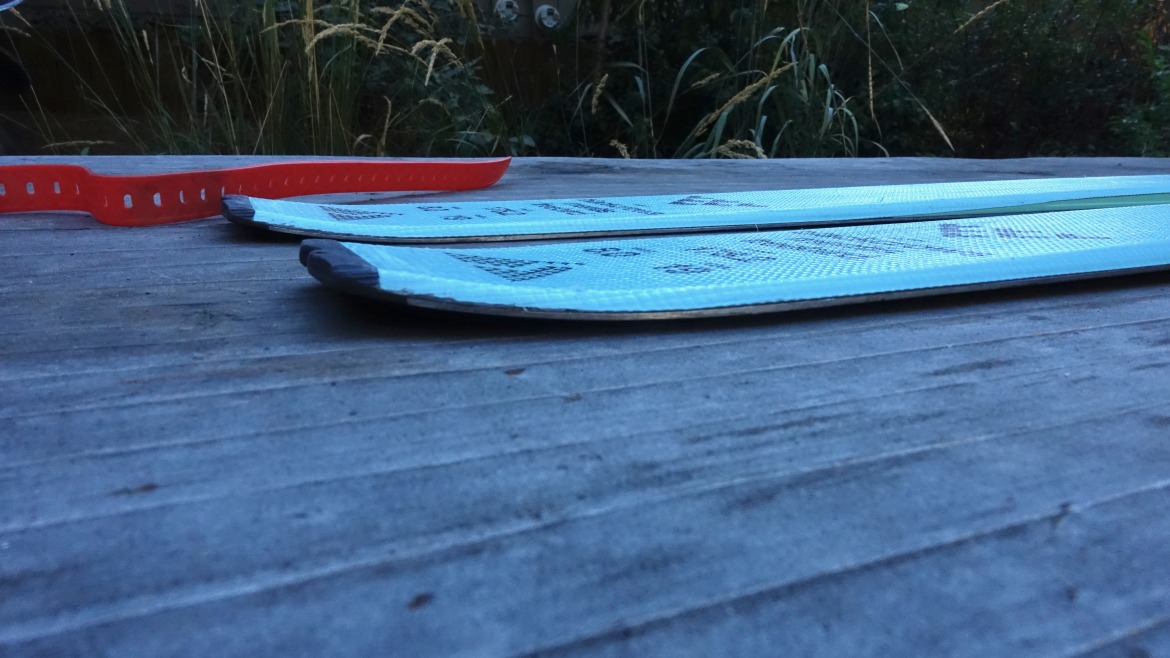
The straight tails (and lack of substantial tail rocker) on the Mentis Freebird is another design feature adding to the skis general stability and 19m turn radius. And, the straight tails insert into firm snow easily — all the better for those using this as a ski mountaineering tool.

The traditional camber underfoot allows for great snow contact. Overall, the tip, camber, and tail design offer up a secure yet playful ski when looking for longer turns.
Mentis Freebird Final Thoughts
If you are checking out the 80mm underfoot ski world, in the Mentis Freebird you’ll find a light ski, but one more related to heavier skis considering its stability and temperament; it is not a tense and too stiff carbon infused offering. I wouldn’t say a nascent uphiller would be taming a wild child with the Mentis Freebird if they desire a good pairing for fitness laps. For more seasoned steep skiers, I think the Mentis Freebird also offers a consistent no-fuss ski that can serve as a Swiss-Army-type tool on mega spring traverses and steep terrain if your style aligns with the 80mm underfoot vibe.
After my love fest with the Mentis Freebird, I just now optioned Google to determine how Mentis translates. Google translate says Mentis means “lie” in English. That’s not what I expected. And I’m confounded unless the keen marketers at Black Crows meant to fool us into thinking a light skinny ski would have to be twitchy. This is the straight-up truth; this long-cambered, perfectly stiff beauty turns like a race GS ski and is no bother on the ascents.
For the time being, I’ve found my ski for fitness laps and dreamy multi-day tours.
Buy the Black Crows Mentis Freebird Ski.
Jason Albert comes to WildSnow from Bend, Oregon. After growing up on the East Coast, he migrated from Montana to Colorado and settled in Oregon. Simple pleasures are quiet and long days touring. His gray hair might stem from his first Grand Traverse in 2000 when rented leather boots and 210cm skis were not the speed weapons he had hoped for. Jason survived the transition from free-heel kool-aid drinker to faster and lighter (think AT), and safer, are better.

